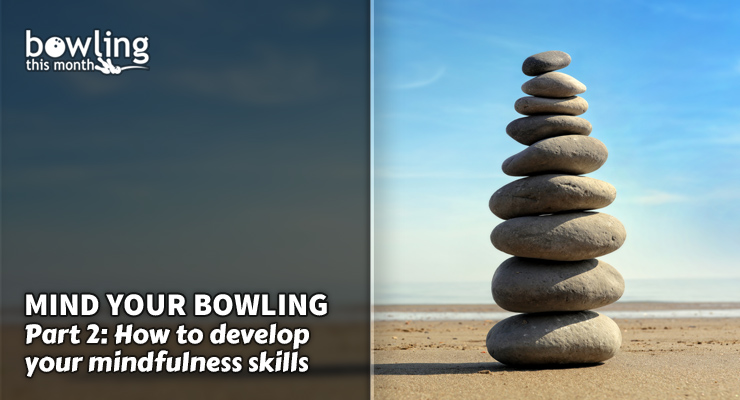Article Contents
- 1. Practice required
- 2. Ways to develop mindfulness
- 2.1. Yoga
- 2.2. Body scan
- 2.3. Breathing exercises
- 2.4. Sitting awareness
- 2.5. Walking awareness
- 3. Mindfulness training and bowling
- 3.1. Bowling drills
- 3.2. Mistakes focus
- 3.3. Get out of your comfort zone
- 4. Mindfulness journal
- 5. Conclusion
- 6. References
Note: This article is only available to Bowling This Month subscribers.
In Part 2 of Mind Your Bowling, I will be discussing some of the practical things you can do to develop your mindfulness skills. There are a number of exercises and activities to practice in this article, and, although it is not expected that every example will resonate with you, I hope you can find some activities that do. As mentioned in Part 1 of this series, it can take as little as three minutes per day of mindfulness training to begin to see the benefits in your on-lane performance.
Practice required
To summarize research from all sports, some of the benefits of using mindfulness are better concentration, better decision-making, faster reaction times, higher mental stamina, and improved memory. It is also shown to reduce stress, reduce burnout, create a higher resilience to fatigue, and encourage better sleep and eating habits. Being able to keep your mind in the present has also been shown to improve communication and emotional control, enhance resilience to adversity, and increase your enjoyment of activities.
It is easy to see that these benefits transfer readily into the sport of tenpin bowling, and especially tournament and team bowling. But, like any skill, it takes practice to develop and perseverance to maintain. And to paraphrase a statement from NBA coach Phil Jackson from Part 1, time spent developing your mental focus is equally important to time spent in the gym. While many bowlers work diligently on their physical games, very few devote the same amount of time and energy to their mental games.
Mindfulness coach Emma Murray’s research suggests that human beings are “off task” 47% of the time. This means that bowlers potentially perform with only 53% of their attention devoted to the game at hand. If you are looking to improve your spare game or increase your carry percentage, increasing your attention levels by even 10% might be enough to do this.
You can do a little experiment to test yourself on this. Set a timer for 45 seconds, close your eyes, and see if you can think of only one thing during that time. How did you go? You aren’t alone if you struggled to do it, as very few people can without training. Can you recall what you did think about? This too is difficult, as your mind can wander randomly from thought to thought quite rapidly.
Murray states that the mind is a muscle that is no different from any other muscle in your body, meaning it is highly trainable. But like building up your muscle strength through exercise, training your mind takes time and effort. And, in this day and age more than any other, we are living in a distraction-filled society. Your brain gets used to pinging from one thing to the other, and then you’re expected to step up on the bowling approach in league or competition and keep your mind in the moment. This is going ...
Already a premium member? Click here to log in.


 (Only
(Only 